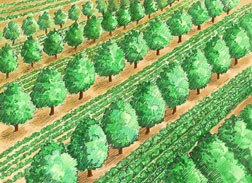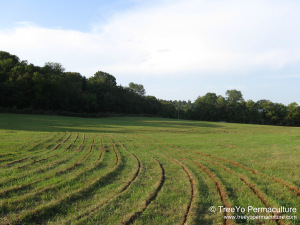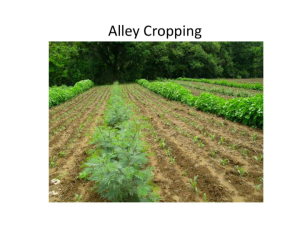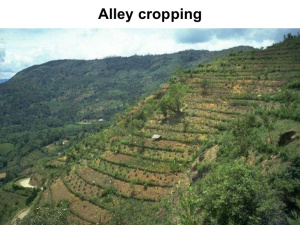Source: treeyopermacultureedu.wordpress.com
Published: May 11, 2017
Written by Doug Crouch
Alley Cropping
While known widely in the agroforestry realm, this technique of inserting lines of trees within croplands is being explored more and more as farm scale Permaculture takes off. It moves from an Agroforestry realm to a Permaculture landscape when the ethics and principles frame its permaculture application. No matter the scale, alley cropping can be a great way to stack in space and time thus creating growing conditions for all sorts of crops in the lines of trees and in between in the alleys. Alley cropping is essentially bringing edge to a landscape to break the monotony of monoculture. By developing rows of trees in your farm landscapes and growing things in between in the alleys, a farm becomes more resilient as trees and their cascade of benefits are realized. Often the aim is long term for the tree crops, but in between the alleys remain productive space for all sorts of crops including grain production, animal rotations, small fruiting shrubs or bushes, or even row crops. It’s a system that could be furthered explored in many already existing commercial systems like cork production in Iberia and other suitable climate analogs in the world. Much energy is put into planting the trees in rows already along with maintaining the alley and in row itself, most often with chemical and mechanical inputs, but could be managed holistically with the use of biological resources.


Creating the Alleys
The decisions around alley cropping design are due to many factors and presses the need to use a design process. Soil types, inclination, orientation, and access to water are all key factors and intertwine with the grander scale of social and economic realms. The idea with the alley cropping is to bring diversity to the farm in terms of yields and economic resilience; all which hinge upon creative human interaction with nature. With that, alleys can be set up on the farm effectively in combination with earthworks. Currently, for example, the cork industry in Portugal uses an earthworks technique known as bancadas, or small earthen banks that follow contour for the most part. These slightly raised beds are how new cork plantations are laid out.

keyline-plow-pattern
However at some point they flow off contour due to the lack of uniformity within a hillsides’ contours. This is the main problem with swales that are on contour as they don’t facilitate staying on-contour and parallel spacing that broad acre cropping requires. However, this is the power of the keyline design when applicable. With the keyline technique of layout, parallel lines are created in the landscape falling from valley to ridge to evenly distribute water throughout the landscape. This exemplary technique of the principle of least change for the greatest effect is once more gaining traction and has allowed a few quite famous farms to sprout up based on this alley cropping idea. One main one that is normally sited is Mark Shepard and his Restoration Agriculture system that emulates the native human cultivated ecosystem, the oak savannah. This is of course the exact ecosystem of the montado in Portugal, the widely spaced Cork and Holm Oak plantations of the past with animal integration. However now the animals have largely been removed which does give farmers an unique opportunity to interplant effectively or bring animals back into the landscape. Furthermore on flat ground one can choose to orientate the rows of trees differently according to aspect. Most often this is done with a east/ west orientation to allow sun to penetrate into the alleys most effectively.


An important part of the alley creation is to remember that it is not an orchard but rather a place where the tree rows are spaced even further to allow abundant sunlight to enter the space between the rows of trees (alleys) for quite some time. This allows for cropping to continue for an extended period until the long term yield is realized and cash flow remains giving a buffer to farm conversion. The alley of trees can be just one single row but also can be several rows of trees. This makes sense in a soil microbiology perspective as keeping a good fungal environment for your trees is important. The cropping alleys will be more bacterial driven so creating three lines of offset trees maybe the best way to go in the end. These trees and shrubs on the outer zone could be more short term harvests of either food, timber, or simply biomass. An example could be for a nut or timber crop of walnuts, either English or Black. To get them to grow straighter and more quickly up with less side branching for timber production, fast growing black locust could be grown on the outside rows and in between the trees. This nitrogen fixer can be harvested for poles and firewood, in particular, but then once coppiced they become a prolific biomass creator of rough mulch as they are quite multifunctional. For nut production a denser shrub like Eleagnus could go on the outside to shelter the young nut trees but not impede the canopy formation. The bigger the canopy the more nuts are produced while reducing side branching in timber production drives up the value in the long term as well.

Selecting the Trees
The trees one will wish to incorporate again depends on your context and climate. What is the yield I want to harvest at the end? It’s very popular in alley cropping for the yield to be for nuts. Most of these trees take quite a while before producing and grow to be quite some size when mature. Because of our current state of agriculture, a farmer can’t just immediately switch from being a corn farmer to a walnut, pecan, or almond farmer overnight more often than not. Again these trees will take time before they produce but a farmer can put in such a crop while also growing corn in between for example. Over the years as the trees grow, the alley edges along the tree rows will become less productive because of overtaking but its also good because ploughing too close to the root base could be quite damaging as well. Again its good to bring diversity further into the landscape besides just your main crop tree. Having support species that yield early helps to turn this agroforestry technique into a reflection and manifestation of the permaculture principles. And it doesn’t have to be just trees in between, herbs could be grown inline for varying end products including essential oils or honey production. Furthermore, the trees themselves can be over or underplanted depending on your intercropping desires. If a tree has a 60 foot (18 m) spacing recommendation you could plant it at 35 ft (10.5 m) and after so many years cut every other one down to take advantage of early yields and the energy that is being put into maintaining the line already. A note to that is that in the tropics things are planted much more dense. While consulting in Malaysia and Sinagaopore (2009) we were recommending taking every third garden bed out since production had dropped from soil degradation in these row cropping markets contexts. This every third planted bed was to be planted instead with fast growing nitrogen fixing trees such as gliricidia that does well with coppicing and also bunching grasses like lemongrass or vetiver. These strips bring diversity and much needed mulch material and despite a 1/3 space reduction would have increased production on the farms we consulted for. This is again why I stress these are climate and context dependent. In this above case, it was the humid lowland tropics and market gardening. Totally different details than the cork farmer of Portugal but that is why we examine patterns to details in Permaculture.




Unique context of contour hedgerows creating alleys for grazing and cropping in the tropics
Alley Cropping/ Silvopasture Bridge
Alley cropping can bridge into another agroforestry technique labeled as Silvopasture. Silvopasture implies animals moving through a treed system where a harvest comes at some point from the trees and animals. This is the mimic of ecosystems like the oak savannah which was present both in Eastern North America with bison and the more cultivated version of Iberia that included both wild and cultivated pigs and other domestic livestock. These represent examples of mature tree systems but when establishing the system of say a new cork plantation, the alleys in between the earthworks could be used for grazing. Even newly planted orchards could take on this alley crop/ silvopasture approach with running chicken tractors in between the rows. This maybe more difficult on slopes, which is where electric bird fencing comes into play with a quite mobile but predator proof coop. Sheep or smaller cattle may also be a good choice to graze between the rows to cycle carbon and reduce mechanical input. Electric fence is used to keep them away from the trees, both their branches but also hoof damage from tree roots while young. An example of this that already exists is incorporating dolly sheep in vineyards in the mediterranean winter to range the rows and control the grasses. Vines like the potassium input from the sheep manure and the grasses are hit back again just before bud break with chickens. This is done in chicken tractors just before the vines break leaf to provide nitrogen and phosphorous. It’s a holistic example but that is the way forward I feel to get off the chemical treadmill. To merge biology with production cropping, silvopasture and alley cropping go together well.

Silvopasture
The silvopasture technique is done in more ways than just the alley cropping fashion yet many of the tips about tree selection and application of permaculture principles still apply. It can also involve widely spaced trees dotted through the landscape or patches of trees to also take advantage of the fungal dominance preference of trees. These tree systems also involve managing grazing below on the mix of herbs and grasses that thrive there. Which

free range chicken at Terra Alta
animal depends normally on the stage of succession that the trees are at or the protection that one affords. In our young yet emerging food forest at Terra Alta (coastal Portugal), it’s a simple free range of chickens. They clean up heaps of insects and cycle carbon efficiently but can make a mess with mulch if not done properly. Applying a rough mulch on top of finer mulches that chickens love to scratch in is a common technique and works effectively to keep mulch in place and the scratching away from tender surface roots. However as chickens fling mulch to the outside they do follow the idea of extending your mulch ring outwardly to keep grasses at bay with the advancing feeder roots. So as the trees mature into several years old, except for citrus, I get less and less worried about root damage from chickens. Furthermore, in larger silvopasture systems trees are grown to provide a long-term yield such as timber, nuts, wildlife forage, or fodder. Again this is how the montado of Portugal is set up with Cork or Holm Oak trees widely spaced where the canopy only meets after several hundred years. It often involves a mix of

Tree Lucerne, an incredibly valuable fodder crop also known as Tagasaste
species, at least traditionally with either sheep or cattle and black pigs. The pigs forage on the acorns in the autumn while the grazers are afforded the grasses. However the grasses grow slow in summer from the dry season and in the winter when soils get too wet and cold. Consequently, the montado could be augmented to also include tagasaste to include a fodder species for chop and drop to the animals to feed on. It could be further enhanced by including Honey Locust as a bean resource that is a mix of carbohydrates and proteins. Carob is already used in that way in the even drier and warmer parts of the southern most province of Algarve, Portugal and other warm Mediterranean climates. Adding fodder tree crops into a pasture is one of the main ways to enact the technique of silvopasture but a tree like tagasaste will have to be well protected when its young.
An example from the cool humid temperate realm comes from an interaction between tree crops and goats, an unlikely combination. Paw Paw, north America’s largest fruit has very potent organic chemistry inside the leaves and bark, which causes the goats to stay away from it in terms of foraging. This means that goats can forage in between the trees and fertilize and even attract more flies for the Paw Paw’s unique pollination from these insects. The farm, Integration Acres in Southeast Ohio, USA, is a Paw Paw champion and has done a wonderful job of creatng

pecan silvopasture
a very unique niche of production and processing of both a myriad of Paw Paw products and a goat dairy. As we move south from there to the warm humid temperate zones the pecan tree has a tradition of widely spacing trees with cattle managing the pastures around. It’s a tree that seems to thrive in this savannah type of atmosphere making it a great choice for silvopasture. Furthermore, in the tropics one of the most amazing landscapes I ever saw was large a large herd of cattle grazing under the massive canopies of nitrogen-fixing acacias set very far apart in the lowland mountains of the Dominican Republic. Their majestic umbrella like growth pattern was truly a site to see. With their thin foliage leaves and the wide spacing, the pastures did not suffer rather the system thrived. The animals I am sure remained cooler and the trees acted as a climatic buffer also to the intense mountain rains. I loved making that part of the drive between two projects I was working on simultaneously in 2013. Regretfully, I didn’t take a picture but this silvopasture landscape will forever be etched in my memory, the color of the grass, the roaming herds, the dappled shade, and the sense of ecosystem tranquility; ahhhh.
